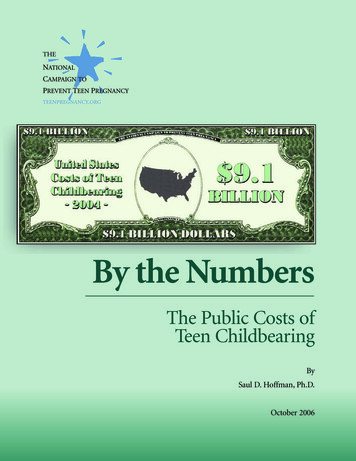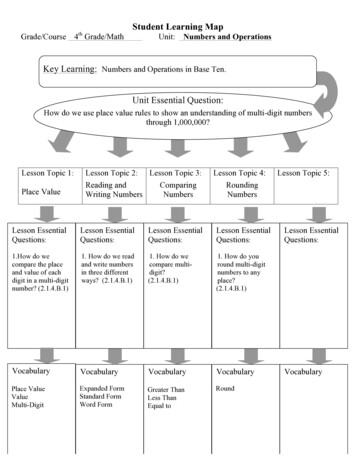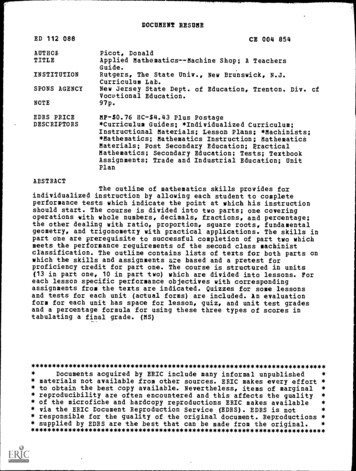
Transcription
By the NumbersThe Public Costs ofTeen ChildbearingBySaul D. Hoffman, Ph.D.October 2006
National Campaign to Prevent Teen Pregnancy Board of DirectorsChairmanThomas H. KeanChairman, The Robert WoodJohnson FoundationFormer Governor of New JerseyRobert Wm. Blum, M.D.,M.P.H, Ph.D.William H. Gates Sr,Professor and ChairDepartment of Populationand Family Health SciencesJohns Hopkins UniversitySusanne DanielsPresidentLifetime EntertainmentServicesDaisy Expósito-UllaChairman and CEOd expósito & partnersWilliam Galston, Ph.D.Senior FellowGovernance StudiesThe Brookings InstitutionDavid R. GergenEditor-at-LargeU.S. News & World ReportAlexine Clement JacksonCommunity VolunteerSheila C. Johnson, Hon.Ph.D.CEO, Salamander FarmJudith E. JonesClinical ProfessorMailman Schoolof Public HealthColumbia UniversityBrent C. Miller, Ph.D.Vice President for ResearchUtah State UniversityJody Greenstone MillerVenture PartnerMAVERON, LLCReverend Father Michael D.Place, STDVice PresidentMinistry DevelopmentResurrection Health CareBruce RosenblumPresidentWarner Bros. TelevisionGroupPresidentIsabel V. Sawhill, Ph.D.Senior FellowThe Brookings InstitutionStephen W. SangerChairman andChief Executive OfficerGeneral Mills, Inc.Linda ChavezPresidentThe Center for EqualOpportunityKurt L. SchmokeDeanHoward UniversitySchool of LawFormer Mayor of BaltimoreAnnette P. CummingExecutive Director andVice PresidentThe Cumming FoundationRoland C. WarrenPresidentNational FatherhoodInitiativeVincent WeberPartnerClark & WeinstockFormer U.S. CongressmanFrankie Sue Del PapaFormer Attorney GeneralState of NevadaWhoopi GoldbergActressStephen A. WeiswasserPartnerCovington & BurlingStephen GoldsmithDaniel Paul Professorof GovernmentJohn F. Kennedy Schoolof GovernmentFormer Mayor ofIndianapolisGail R. Wilensky, Ph.D.Senior FellowProject HOPEKatharine Graham(1917-2001)Washington Post CompanyKimberlydawn Wisdom,M.D.Surgeon GeneralState of MichiganDavid A. Hamburg, M.D.President EmeritusCarnegie Corporation ofNew YorkVisiting Scholar,Weill Medical CollegeCornell UniversityJudy WoodruffJournalistSpecial CorrespondentPBS News HourTrusteesEmeritiCharlotte BeersFormer Under Secretaryfor Public Diplomacyand Public AffairsU.S. Department of StateFormer Chairman and CEOOgilvy & MatherCarol M. Cassell, Ph.D.Senior ScientistAllied Health CenterSchool of MedicinePrevention Research CenterUniversity of New MexicoIrving B. Harris(1910 - 2004)ChairmanThe Harris FoundationBarbara HubermanDirector of TrainingAdvocates for YouthLeslie KantorKantor ConsultingNancy Kassebaum BakerFormer U.S. SenatorDouglas Kirby, Ph.D.Senior Research ScientistETR AssociatesDirector and TreasurerSarah S. BrownC. Everett Koop, M.D.Former U.S.Surgeon GeneralJohn D. MacomberPrincipalJDM Investment GroupSister Mary Rose McGeadyFormer President and CEOCovenant HouseJudy McGrathPresidentMTVKristin Moore, Ph.D.Area Director,Emerging IssuesChild Trends, Inc.John E. PepperCEO, NationalUnderground RailroadFreedom CenterHugh PriceSenior FellowEconomic StudiesThe Brookings InstitutionWarren B. RudmanSenior CounselPaul, Weiss, Rifkind,Wharton & GarrisonFormer U.S. SenatorVictoria P. SantPresidentThe Summit FoundationIsabel StewartFormer Executive DirectorGirls Inc.Andrew YoungChairmanGoodWorks InternationalFormer Ambassadorto the U.N.
By the NumbersThe Public Costs ofTeen ChildbearingBySaul D. Hoffman, Ph.D.October 2006
AcknowledgmentsThe National Campaign to Prevent Teen Pregnancy gratefully acknowledges the William T. GrantFoundation for making this important project on the public costs of teen childbearing possible. Both thispublication, which covers the national costs of teen childbearing, and the related 51 fact sheets detailing stateand District of Columbia costs of adolescent childbearing reflect the Foundation’s generous support.The National Campaign also extends appreciation to its other funders and individual contributors,including the William and Flora Hewlett Foundation, the Robert Wood Johnson Foundation, the Annie E.Casey Foundation, and the Summit Fund, for generously supporting the full range of National Campaignactivities. We also acknowledge and thank the Centers for Disease Control and Prevention for their support ofselected National Campaign research projects.In particular, the National Campaign extends warm appreciation to Saul Hoffman for his scholarship andpatience throughout the complex process of developing this report. We also thank Dr. Rebecca Maynard, theeditor of the landmark study, Kids Having Kids, on which this analysis is based. Many other individuals contributed to the success of this report including National Campaign Board President Isabel Sawhill, andNational Campaign staff Andrea Kane, Cindy Costello, Katy Suellentrop, Kristen Tertzakian, Jill Shelly, JessicaSwafford, Michael Rosst, and Jessica Sheets. And we also offer special thanks to Jennifer McIntosh for her hardwork and dedication to identifying state cost information. We are grateful to the National Campaign’s Stateand Local Action and Effective Programs and Research Task Forces for their wise guidance, as well as to individuals in Delaware and Texas who graciously served as pilot sites for the state cost estimates and providedexcellent advice.Saul Hoffman would like to thank Dr. Rebecca Maynard for leading the way on this research and for themany constructive suggestions that have improved this paper as well as the many authors whose scholarshipmade Kids Having Kids possible. Copyright 2006 by the National Campaign to Prevent Teen PregnancyISBN #: 1-58671-064-8Suggested citation: Hoffman, S. (2006). By the Numbers: The Public Costs of Teen Childbearing.Washington, DC: National Campaign to Prevent Teen Pregnancy
Effective Programs and Research Task ForceThis paper was reviewed by the National Campaign’s Effective Programs and Research Task Force. Wealso acknowledge the important contributions of National Campaign President Isabel Sawhill, Ph.D., SeniorFellow, Economic Studies and Co-Director of the Center on Children and Families at the BrookingsInstitution.ChairMelissa S. Kearney, Ph.D.Susan Philliber, Ph.D.Brent Miller, Ph.D.Senior FellowEconomic StudiesBrookings InstitutionSenior PartnerPhilliber Research AssociatesVice President for ResearchUtah State UniversityJohn Santelli, M.D., M.P.H.Daniel T. Lichter, Ph.D.MembersKathryn Edin, Ph.D.Associate Professor of SociologyUniversity of PennsylvaniaSaul D. Hoffman, Ph.D.ProfessorDepartment of EconomicsUniversity of DelawareJim Jaccard, Ph.D.ProfessorDepartment of PsychologyFlorida International UniversityProfessorDepartment of PolicyAnalysis & ManagementCornell UniversityHeilbrunn Department ofPopulation and Family HealthMailman School of Public HealthColumbia UniversityMatthew Stagner, Ph.D.William Marsiglio, Ph.D.ProfessorDepartment of SociologyUniversity of FloridaRebecca A. Maynard, Ph.D.University Trustee Chair ProfessorUniversity of PennsylvaniaAnne Meier, Ph.D.Assistant ProfessorDepartment of SociologyUniversity of MinnesotaExecutive DirectorChapin Hall Center for ChildrenStan Weed, Ph.D.DirectorInstitute for Research& Evaluation
Summary:How Much DoesTeen Childbearing Cost?Early pregnancy and childbearing remainpressing concerns in the United States. In 2002, TEEN CHILDBEARINGthere were over 760,000 pregnancies to womenunder the age of 20 and some 420,000 births to COSTS TAXPAYERS ATteens in 2004. Despite a 36 percent drop in theLEAST 9.1 BILLIONteen pregnancy rate between 1990 and 2002 (theANNUALLYmost recent data available) and a 33 percentdecline in the teen (girls aged 15-19) birth ratebetween 1991 and 2004, the United States still has the highest teen pregnancy and birth rates inthe industrialized world. In fact, rates of teen pregnancy in the United States are two to six timeshigher than those in most of Western Europe including France, Holland, Denmark, and Sweden. Teen childbearing is associated with adverse consequences for teen mothers, fathers, and theirchildren. Teen childbearing is also costly to the public sector—that is, to federal, state, and localgovernments and the taxpayers who support them. While the consequences of teen childbearingare many, this report focuses exclusively on the public sector costs of teen childbearing.A decade ago, a group of researchers estimated that births to mothers age 17 and youngercost taxpayers nearly 7 billion annually. Costs to society as a whole were more than twice asmuch as that. These cost figures, presented in the award-winning and widely cited book KidsHaving Kids: Economic Costs and Social Consequences of Teen Pregnancy, compared the costsof childbearing by teen mothers 17 and younger to the costs of childbearing by mothers aged20-21.By the Numbers: The Public Costs of Teen Childbearing1
The new research detailed in this report provides: updated estimates of the public sector costs of teen childbearing in 2004; cost estimates of childbearing for those aged 17 and younger and for those aged 18-19; the first-ever estimates of the cost of teen childbearing in each state and Washington DC.(Please see Appendices 1-6 for state cost information and visit www.teenpregnancy.org/costs for detailed fact sheets on each state and Washington DC.)The report’s primary findings include: Teen childbearing in the United States cost taxpayers (federal, state, and local) at least 9.1 billion in 2004. Put another way, the average annual cost associated with a childborn to a teen mother is 1,430. Most of the costs of teen childbearing are associated with negative consequences for thechildren of teen mothers. These costs include 1.9 billion for increased public sectorhealth care costs, 2.3 billion for increased child welfare costs, 2.1 billion for increasedcosts for state prison systems, and 2.9 billion in lost revenue due to lower taxes paidby the children of teen mothers over their own adult lifetimes. The public sector costs of young teens (those aged 17 and younger) having children areparticularly high. These births account for 8.6 billion of costs, an average of 4,080per mother annually. The taxpayer costs associated with teen childbearing to those aged 18-19 are estimatedat 0.4 billion annually. Between 1991 and 2004 there were 6,776,230 births to teens in the United States.The estimated cumulative public costs of teen childbearing during this time period is 161 billion dollars. The steady decline in the teen birth rate between 1991 and 2004 has already yielded substantial cost savings. As noted above, the national teen birth rate declined by one-thirdbetween 1991 and 2004. This progress in reducing teen childbearing saved taxpayers anestimated 6.7 billion in 2004 alone. Because not all costs can be measured, and because the estimates themselves are constructed conservatively, it is certain that the full public sector costs of teen childbearingare larger than those noted in this analysis.The cost estimates presented in this report are divided into two broad categories: (1) thoseassociated with teen mothers and their partners, and (2) those associated with the children ofteen mothers. The public costs for teen mothers are measured as the difference in the taxes thatthey pay because their earnings are lower and the difference in the cost of public assistancethey receive (TANF, Food Stamps, and housing assistance). The costs for fathers are also associated with lower taxes paid. For the children, the costs are those associated with publiclyprovided health care, foster care and other child welfare services, incarceration (for sons ofTHE NATIONAL CAMPAIGN TO PREVENT TEEN PREGNANCY2
Figure 1: Public Sector Costs of a First Birth to a Teen MotherCompared to a First Birth at Age 20-21All Costs in Billions of 2004 DollarsOUTCOME MEASURES1st Birth atAge 17or Younger1st Birth atAge 18-191st BirthAge 19and YoungerLost Tax RevenueIncome & Sales Taxes (Mothers)Income & Sales Taxes (Fathers)Income & Sales Taxes (Children) 4.89 1.43 6.32 0.92 1.71 2.26- 0.65 1.45 0.63 0.27 3.16 2.89Public Assistance (Mothers)- 0.95- 2.62- 3.56TANFFood StampsHousing- 0.72- 0.45 0.22- 1.26- 0.91- 0.45- 1.98- 1.35- 0.23Health Care Costs (Children) 0.95 0.98 1.92Child Welfare (Children) 1.84 0.46 2.30Incarceration of Sonsof Teen Mothers (Children) 1.90 0.17 2.07Total Annual Cost (Billions) 8.63 0.42 9.06Numbers in this table and throughout the report may not quite total due to rounding.teen mothers as adults), and lost tax revenue due to lower earnings when the children of teenmothers enter the labor force.The cost estimates provided in this report are based on a very conservative researchapproach that only includes costs that can be confidently attributed to teen childbearing itselfrather than to other traits or disadvantages that often accompany teen childbearing (such aspoverty). While this report presents new estimates of the national costs of teen births, it drawson the work of many of the same researchers who developed the original 1996 estimates presented in Kids Having Kids and it follows the same conservative research approach.While no estimate of the cost of teen births can ever be perfect and beyond critique, thecosts presented here reflect state of the art research techniques, are the fullest and most reliable estimates to date, and reflect only those costs clearly associated with a teen birth ratherthan associated risks. The goal of this new research is to provide timely, scientifically soundevidence of the public costs that teen births impose on the public sector in the United Statesand to make apparent the economic value of preventing early childbearing.By the Numbers: The Public Costs of Teen Childbearing3
THE NATIONAL CAMPAIGN TO PREVENT TEEN PREGNANCY4
Context:Teen Births in the United Statesnomic development and are even higher thancountries with far lower average incomes. Onestudy compared the United States to 45 developedcountries—from Albania to Yugoslavia—as of thelate 1990s (Singh and Darroch). Of these 45 countries, just one had a higher teen fertility rate—Armenia, which barely nosed out the United States.In much of Europe, teen birth rates were one-quarter to one-fifth of the rate in the United States.Denmark, France, Germany, Netherlands, Portugal,Spain, Sweden and Switzerland are just some of themany European countries with teen birth rates afraction of our own. Our close neighbor Canadahas a teen birth rate less than half the U.S. rate.Clearly, despite the country’s substantial progress,there is still much room for improvement. Forexample, the National Campaign estimates thatnearly one-third of young women in the UnitedStates become pregnant by age 20.Teen pregnancy and birth rates in the UnitedStates have fallen steadily since the early 1990s,when nearly a decade of steady and substantialincreases in the rates came to an end. In 1991, morethan one million adolescent girls became pregnantand more than half a million had a birth. Of every1,000 girls aged 15-19 in 1991, 116 became pregnant and 62 had a birth.Now, after more than a decade of decline, theteen birth rate is a third lower than in 1991. Insteadof 62 births for every 1,000 15-19 year old girls,there are just 41 (Martin, et al).Still, despite the very substantial progress inreducing the teen birth rate since 1991, the UnitedStates’ rates of adolescent pregnancy and childbearing are still conspicuously different from othercountries that share our level of income and eco-By the Numbers: The Public Costs of Teen Childbearing5
THE NATIONAL CAMPAIGN TO PREVENT TEEN PREGNANCY6
The Cost of a Teen Birth:What the Study Measures and HowDetermining the cost of a teen birth is a complex research task. It is particularly important,therefore, to be clear about what is being measuredand how it is being measured. Different measures ofcosts are appropriate for different purposes. Theprimary goal is to measure the costs that could beaverted if today’s teen mothers delayed their firstbirth to their early 20s. The focus is on public sector costs—that is, those costs paid for by the state,local, or federal government with revenue providedby federal, state and local taxpayers.While this procedure is straightforward inprinciple, executing it is difficult. The major challenge is that it is often difficult to determine howmuch of the poorer outcomes of teen mothers,their partners, and their children are due to theearly age of first birth and how much is due toother risk factors. The young women who becometeen mothers often face many disadvantages arisingfrom the families and communities in which theylive. Their families may have lower average income,their communities may have fewer public amenitiesand support systems, and their public school systems may be weaker. Each of these disadvantages,including the early age of their first birth, contributes uniquely to the poorer outcomes for thesewomen, their partners, and their children. If toomuch weight is assigned to giving birth as a teen,there is a very real risk of overstating what can beaccomplished by a delay in the age at first birth.The first step in measuring the costs of a teenbirth is to determine how giving birth as a teenalters subsequent life outcomes for the teen mother(e.g., her educational attainment, earnings, andwelfare receipt), the father (e.g. earnings), as well asthe life course of the child born to the teen mother(e.g., health, educational attainment, and earnings).The second step is to determine the cost per personof providing specific public services that resultfrom these altered outcomes. Combining theimpact of a having a birth as a teen with the perperson cost of program services and summing upall relevant outcomes and programs yields a measure of the costs of teen childbearing.Therefore, in measuring the impact of a teenbirth, it is particularly important to attempt toidentify the unique or causal role that age aloneplays in whatever poor outcomes are noted. Thecausal role corresponds to this thought experiment:“If we could change a young woman’s age at firstbirth, but not change anything else about her, whatBy the Numbers: The Public Costs of Teen Childbearing7
impact would that have on her subsequent life outcomes and the life outcomes of her child and partner?” The resulting impact of a teen birth is its neteffect, that is, its effect above and beyond theimpact of other risk factors that are not changed.The net effect represents a causal impact, not just acorrelation.THIS REPORT PROVIDES APUBLIC SECTOR COST ANSWER TOTHE FOLLOWING QUESTION: “IF WE COULD CHANGE A YOUNGWOMAN’S AGE AT FIRST BIRTH,BUT NOT CHANGE ANYTHINGELSE ABOUT HER, WHAT IMPACTTo compute the net effect of teen childbearing,it is necessary to compare young women who are assimilar as possible in all respects except for the ageat which they first had a birth. This is done using avariety of statistical techniques that control for oradjust for all the other risk factors that contribute tothe outcome being studied. The specific way inwhich this is done varies from study to study,depending on the data source that is used and themeasures of family and community available in thatdata. The result is equivalent to finding the averagedifference in outcomes between young women whoare identical except for the ages at which they firsthad births.WOULD THAT HAVE ON HERSUBSEQUENT LIFE OUTCOMESAND THE LIFE OUTCOMES OFHER PARTNER AND HER CHILD?”the children of women who are 20 or 21 at the timeof their first birth? In measuring this, it is important to carefully account for other risk factors thatalso affect the probability that a young child entersfoster care in order to identify the causal effect of ateen birth. Second, it is necessary to determine theannual cost of a typical foster care case by combining detailed cost and caseload data. Combiningthese two quantitative estimates—the net impact ofa mother’s age at birth and the cost per case—andmultiplying by the number of teen births in 2004yields an estimate of the impact of a teen birth onfoster care costs.1The cost of a teen birth is then the increasedcosts associated with the net effect of a teen birthon a wide range of outcomes. This cost measure—referred to throughout the report as the net cost of ateen birth—includes the costs that could potentiallybe averted if a first birth were delayed. Alternatively,these are the benefits or cost savings of delaying theage of first birth.It is important to understand that thisapproach yields a conservative measure of the costof a teen birth in the sense that it does not attributeto teen childbearing the impact of other correlatedfamily and community factors.2 A less conservativemeasure is the gross cost of a teen birth. This measure is based on the full or unadjusted differencebetween teen mothers and mothers aged 20-21 inthe many outcomes that lead to public sector costs.The concept of gross costs of a teen birth corresponds to this thought experiment: “If we couldchange a young woman’s age at first birth and allother differences between her and the averagewomen who has a later birth, how much lowerConsider, for example, the foster care system inthe United States, which, along with associatedchild welfare programs, costs federal, state, andlocal taxpayers more than 23 billion annually.What is the impact of the mother’s age at birth onthe costs of maintaining the foster care system inthe United States? To answer that question, it isnecessary to first determine the causal impact of ateen birth on the probability that a child will enterthe foster care system. How much more likely arechildren of teen mothers to enter foster care than12See the Appendix for detailed information about how all cost estimates are constructed.This measure might be too conservative in one way. A successful teen pregnancy intervention program will almostalways change something about a young woman that enables her to delay her first birth. If that "something" is valuable inthe labor market or elsewhere, it may improve her prospects. The statistical practice of "holding everything else constant" does not typically allow for this indirect effect.THE NATIONAL CAMPAIGN TO PREVENT TEEN PREGNANCY8
would public sector costs be for her and her children?” The gross costs reflect the correlationbetween a teen birth and the various outcomes,rather than a causal relationship.government programs and taxes as of 2004 andmeasured in 2004 dollars. The appendix explainsexactly how the births in 2004 are used to estimatethe annual cost of teen births.Typically, the gross cost of a teen birth is largerthan the net cost and sometimes much larger.3 Asalready noted, the young women who become teenmothers usually differ in many ways from thewomen who delay their first birth and those otherdifferences are sometimes important contributorsto the outcomes that are being analyzed. It is alwayspossible that teen mothers may do poorly for reasons other than the age at which they have a child.A comparison of gross and net costs reveals theimpact of other risk factors on the outcomes ofinterest. The gross costs themselves are also a meaningful measure of costs that could be avoided by acomprehensive and aggressive intervention program that addressed all the disadvantages of potential teen mothers.The public sector costs included in this analysisare limited to those linked to outcomes that havedollar costs associated with them and for whichthere are reliable national estimates of the netimpact of a mother’s age at birth on that outcome.Some things, such as life satisfaction, are important,but do not have measurable and explicit dollarcosts. Others do have measurable dollar costs, butreliable net impact estimates from representativesamples are not available. For example, the childrenof teen mothers may have educational issues thatcause them to disproportionately use costly publicschool services for special education, but there areno reliable national estimates of the net impact ofteen childbearing on this outcome. Again, becausenot all costs can be measured and included, it iscertain that the full costs of a teen birth are greaterthan the cost estimates presented here.The costs measured in this study are based onthe total number of teen births in 2004. There were422,043 teen births in 2004 of which 140,761 werebirths to girls age 17 and younger, (including 6,781to girls age 10-14), and another 281,282 were birthsto girls age 18 and 19. The costs are those associatedwith a specific number of years of motherhood,beginning either with a teen birth or a birth delayedto ages 20 or 21. In some instances, the costs aremeasured through the first 15 years of motherhood; in other cases the costs are measured for ashorter or longer period of time. Readers shouldnote that in all cases, however, the specific ages arenoted throughout the paper. Age 20-21 was chosenas the age for delay of first birth because it is longenough to make a meaningful difference in the lifeoptions of the young mothers and their childrenand because it is potentially attainable throughaggressive and effective efforts to prevent teen pregnancy. The costs measured here are the annual costsof a teen birth, based on the characteristics of3The costs that are examined fall into two broadcategories: those for this generation (the teenmother and the father of her child) and those forthe next generation (the children of teen mothers).For the mother and father, the public costs are thedifference in the taxes that they pay due to lowerearnings as compared to older mothers and theirpartners. Also for the mothers, the public costs arethe difference in the cost of public assistance theyreceive—TANF, Food Stamps, and housing assistance—compared to mothers who delay childbearing until age 20-21. For the children, the costs arethose associated with publicly-provided health care,foster care and other child welfare services, incarceration as adults (sons only), and the lower taxesassociated with their lower earnings when theyenter the job market (due to lower educationalattainment).A third and yet larger measure of the costs of a teen birth includes the costs of all the services consumed by teen mothersand their families. This measure implies that it is possible to eliminate all of the costs of teen childbearing by delaying ayoung woman’s age at first birth. That, unfortunately, is unlikely to be true. There are also public sector costs for someolder mothers and their children.By the Numbers: The Public Costs of Teen Childbearing9
The cost estimates presented here are based onthe average impact of a mother’s age at birth on themothers, fathers, and their children. Because teenmothers, their partners, and their children are individuals, each one is unique in some way. Their lifeexperiences after a birth will vary considerably.Certainly, some will have lives that are very different from this average. Undoubtedly, some may faremuch better than the average and some muchworse. Nothing in the analysis implies or requiresthat each teen birth will impose the costs that wedescribe.TEEN MOTHERS,THEIR PARTNERS,AND THEIR CHILDREN ARE ALLUNIQUE IN SOME WAY. THEIR LIFEEXPERIENCES AFTER A BIRTH WILL VARY CONSIDERABLY. CERTAINLY,SOME WILL HAVE LIVES THATARE VERY DIFFERENT FROM THISAVERAGE. UNDOUBTEDLY,SOME MAY FARE MUCH BETTERTHAN THE AVERAGE ANDSOME MUCH WORSE.THE NATIONAL CAMPAIGN TO PREVENT TEEN PREGNANCY10
Costs of Teen Childbearing:Consequences for the ChildrenHealth and Medical CareThe public sector costs of teen childbearingdetailed below are divided into costs for those aged17 and younger at the time of a birth and costsassociated with births to those aged 18-19. Readerswill note that the net costs to younger mothers arefar greater than the net costs to older mothersdespite the fact that they account for only aboutone-third of all teen births. This is due, in part, tothe fact that the delay for younger mothers to age20-21 is longer than the delay for the older mothersand also because the teen mothers aged 18-19 aremore mature at the time of the birth. As a result,the net effects of a teen birth are much greater foryoung teen mothers than for the older teenmothers.Young Teen Mothers – Age 17 and YoungerResearch about the health status of the childrenof young teen mothers presents a complex picture.As of the late 1980s, children of teen mothers hadpoorer health (self-reported) than the children ofolder mothers (Wolfe and Perozek), but a morerecent examination based on a 2002 study using theMedical Expenditure Panel Survey (MEPS) findslittle or no difference in self-reported health status(Wolfe and McHugh). This newer study finds thatchildren of young teen mothers are slightly morelikely to have a chronic medical condition, but lessFigure 2: Health Care Costs of a First Birth to a Teen Mother Compared to a First Birth at Age 20-21All Costs in Billions of 2004 DollarsOUTCOME MEASURESHealth Care Costs - Children1st Birth atAge 17or Younger1st Birth atAge 18-19 0.95 0.98By the Numbers: The Public Costs of Teen Childbearing111st BirthAge 19and Younger 1.92
likely to report an acute condition.4 Also, theirmothers are about as likely to report that their children are in “excellent” health and no more likely toreport “fair or poor” health. It is clear that childrenof young teen mothers are less likely to see a medical provider than the children of older mothers.Based on the new estimates of the net impactof a a mother’s age at birth on public sector healthcosts per child, the corresponding total annual coststo federal, state, and local taxpayers in 2004 forchildren from birth to age 14 are estimated to be 950 million.At young ages (0-4), annual health expenditures are 25-40 percent larger for children of teenmothers 17 and younger than for the children ofmothers who were age 20 or 21 at first birth, butfrom ages 4-7, health expenditures are considerablyless than for the other children. On average, fromage 1-14, the children of teen mothers
teen pregnancy rate between 1990 and 2002 (the most recent data available) and a 33 percent decline in the teen (girls aged 15-19) birth rate between 1991 and 2004, the United States still has the highest teen pregnancy and birth rates in the industrialized world. In fact, rates of teen pregnancy in the United States are two to six times










